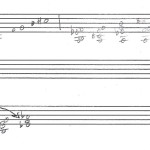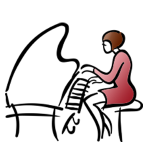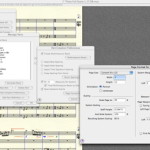I’m back! I’ve sent off my score to the San Diego Chamber Orchestra! And in a few weeks I fly out to California to attend the rehearsals and première. Onward and upward, woo hoo!
By popular request (the populace consisting of McDoc), I’m going to write about how a piece goes from being finished, composing-wise, to being ready to deliver to performers in a beautiful, shiny package containing lots and lots of straight lines and little black dots. Here goes.
Finishing the piece is just the beginning. Then comes the fun part!
The craft of music copying (also called “score preparation”) fits perfectly with my temperament and personality, because I am both an incorrigible perfectionist and a hard-core introvert. Copying requires a lot of fine-detail tinkering, in sweet, solitary communion with the computer. (I’m not kidding about the introvert thing; I took the Meyers-Briggs personality questionnaire, and evidently I’m more introverted then 90% of the population. It’s not that I dislike being around people — I just have a threshold for it, beyond which I vant to be alone. The threshold doesn’t apply to McDoc, however. I’m quite content to go for very long stretches without a break from him! 😉 )
In its solitary perfectionism, copying is similar to composing, but it’s less demanding creatively and emotionally. I find it very easy when I’m copying to get into that state of “flow,” where you forget yourself and are unaware of time passing.
In short, if I could get a real paying job as a music copyist, I’d be happy as a clam. I have done paid copying work in the past; one drawback is that you’re usually working on a break-neck, last minute time line. This is because while composers need deadlines to motivate them, they always miss those deadlines. I can say that because I’m a composer myself. You can take that to the bank! 😉
Click Mr. Readmore to find out how it all works!
Just as many folks nowadays aren’t aware that there are still composers writing classical music today (“composer” evoking the image of a dead European guy wearing velvet knickers), many people don’t realize that music scores are still being created as well. The good news is, you don’t have to write them on special paper with a fountain pen or etch them on metal plates any more! Like many professions, music copying is now a computer-aided pursuit.
That was then
When I first started composing, music notation software was relatively new, and it was both expensive and unsophisticated, compared to what we have now. I wrote my early pieces by hand. I copied out one piece in ink, and while it was pretty and gave me a wonderful sense of achievement, there wasn’t enough Liquid Paper in the world to make it worth the hassle. So I got the darkest pencils I could find, and I pressed really hard. I went through a lot of those white Magic Rub erasers (which are still the only type of erasers I use today, on those rare occasions when I actually use a pencil and paper. My handwriting has deteriorated to the point where I could be mistaken for a medical doctor rather than a music almost-doctor!)
Some of my fellow composer friends got very serious and fancy about the hand-written score thing, and their scores were works of art. There are numerous accoutrements one could use; various rulers and templates for drawing perfect beams and hairpins, compasses for drawing beautiful slurs, even an electric eraser (don’t let the power cord fool you — it actually runs on swear words). As much of a perfectionist as I am, I did not have the patience for drawing all my stems and beams with a ruler, and my hand-written scores never looked all that wonderful to me, no matter how hard I tried.
I remember very well the last piece I copied by hand. It was a wind quintet, and copying it took two days, at the end of which my right hand was so stiff, I couldn’t move it for a further two days. I decided it was time to go digital. I plunked down my cash-ola for Finale 3.0 (happily, I qualified for the student discount at the time), and I never looked back. By that time, the software had improved significantly, but it was still headache-inducing in many ways. It devoured all the CPU power your computer could possibly muster, the files were huge, and it crashed frequently. It basically behaved the way audio editing software does today! 😛 And boy, could it be S-L-O-W. Many types of edits would require the screen to redraw itself after you made them; I remember hearing a composer joke that he could go and make himself a cup of coffee every time he waited for his screen to redraw.
The program has continued to improve over the years, though. Somehow, they’ve been able to make it so that files are now no bigger than word-processing docs. It crashes far less often. It has pretty decent audio capabilities and built-in MIDI sounds (with which listeners to the 30 Days Project are familiar!), so you can create an audio file directly from the notation file (I still tend to load the audio files into my audio editor to tinker with them further, but I don’t always have to). I haven’t checked out the competition (Sibelius) in a while, but some people swear it’s much easier to use. I’d be willing to try it, but usually what happens is I really need to get a project done, so I stick with what I know. They say the learning curve is steeper with Finale than it is with Sibelius, which may be true if you’re starting from scratch, but I know Finale well enough to use it in my sleep (and when I’m working on a project that has me using it several hours a day, I do tend to start dreaming in Finale, which is pretty weird 😛 ).
Coming up next: a little guided tour of what it’s like to prepare the score and parts for an orchestra piece — with screen shots! Stay tuned… 🙂
If you enjoyed this post, would you consider…
Thanks — you make the world a better place! 🙂





I’ve done some music transcribing, and have drawn up parts for a brass quintet, so I know well how much work creating parts is.
And no, my musical script was never very pretty either.
I’m looking forward to the next installment!
AA
Now here’s an aspect of music about which I know nothing! This is really interesting. As a chorale singer, I have read my share of handwritten scores in mice-type and other horrors. I much prefer a nice, neat score and now appreciate how it gets that way.
Good luck in sunny SoCal.
I write out the notes like most rock “musicians” do:
G G B E C
and so on.
My organ and cello teachers when I was a kid would be appalled.
scott — what terrible thing did you do to land you in organ lessons as a kid? 😉